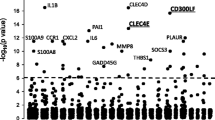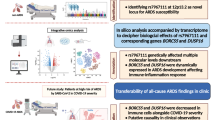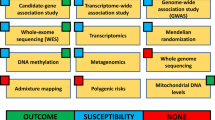Abstract
Purpose
The purpose of this study was to profile genetic causal factors of acute respiratory distress syndrome (ARDS) and early predict patients at high ARDS risk.
Methods
We performed a phenome-wide Mendelian Randomization analysis through summary statistics of an ARDS genome-wide association study (1250 cases and 1583 controls of European ancestry) and 33,150 traits. Transcriptomic data from human blood and lung tissues of a preclinical mouse model were used to validate biomarkers, which were further used to construct a prediction model and nomogram.
Results
A total of 1736 traits, including 1223 blood RNA, 159 plasma proteins, and 354 non-gene phenotypes (classified by Biochemistry, Anthropometry, Disease, Nutrition and Habit, Immunology, and Treatment), exhibited a potentially causal relationship with ARDS development, which were accessible through a user-friendly interface platform called CARDS (Causal traits for Acute Respiratory Distress Syndrome). Regarding candidate blood RNA, four genes were validated, namely TMEM176B, SLC2A5, CDC45, and VSIG8, showing differential expression in blood of ARDS patients compared to controls, as well as dynamic expression in mouse lung tissues. Importantly, the addition of four blood genes and five immune cell proportions significantly improved the prediction performance of ARDS development, with 0.791 of the area under the curve from receiver-operator characteristic, compared to 0.725 for the basic model consisting of Acute Physiology and Chronic Health Evaluation (APACHE) III Score, sex, body mass index, bacteremia, and sepsis. A model-based nomogram was also developed for the clinical practice.
Conclusion
This study identifies a wide range of ARDS relevant factors and develops a promising prediction model, enhancing early clinical management and intervention for ARDS development.





Similar content being viewed by others
Data availability
For the iSPAAR consortium dataset, the genotype data and relevant covariate information (age, sex, ancestry, principal components, etc.) are deposited in dbGaP under accession code phs000631.v1.p1. For MESSI and the African American dataset, dbGaP submission is forthcoming in accordance with the NIH genomic data sharing policy. In advance of their availability on dbGaP, full summary statistics are available on reasonable request to the authors.
References
Fan E, Brodie D, Slutsky AS (2018) Acute respiratory distress syndrome: advances in diagnosis and treatment. JAMA 319:698–710
Meyer NJ, Gattinoni L, Calfee CS (2021) Acute respiratory distress syndrome. Lancet 398:622–637
Bellani G, Laffey JG, Pham T, Fan E, Brochard L, Esteban A, Gattinoni L, van Haren F, Larsson A, McAuley DF, Ranieri M, Rubenfeld G, Thompson BT, Wrigge H, Slutsky AS, Pesenti A (2016) Epidemiology, patterns of care, and mortality for patients with acute respiratory distress syndrome in intensive care units in 50 countries. JAMA 315:788–800
Ñamendys-Silva SA, Gutiérrez-Villaseñor A, Romero-González JP (2020) Hospital mortality in mechanically ventilated COVID-19 patients in Mexico. Intensive Care Med 46:2086–2088
Bernard GR, Artigas A, Brigham KL, Carlet J, Falke K, Hudson L, Lamy M, Legall JR, Morris A, Spragg R (1994) The American-European European Consensus Conference on ARDS. Definitions, mechanisms, relevant outcomes, and clinical trial coordination. Am J Respir Crit Care Med 149:818–824
Kojicic M, Li G, Hanson AC, Lee K-M, Thakur L, Vedre J, Ahmed A, Baddour LM, Ryu JH, Gajic O (2012) Risk factors for the development of acute lung injury in patients with infectious pneumonia. Crit Care 16:R46
Lee A, Festic E, Park PK, Raghavendran K, Dabbagh O, Adesanya A, Gajic O, Bartz RR (2014) Characteristics and outcomes of patients hospitalized following pulmonary aspiration. Chest 146:899–907
Treggiari MM, Hudson LD, Martin DP, Weiss NS, Caldwell E, Rubenfeld G (2004) Effect of acute lung injury and acute respiratory distress syndrome on outcome in critically ill trauma patients. Crit Care Med 32:327–331
Asselah T, Durantel D, Pasmant E, Lau G, Schinazi RF (2021) COVID-19: discovery, diagnostics and drug development. J Hepatol 74:168–184
Reddy MP, Subramaniam A, Chua C, Ling RR, Anstey C, Ramanathan K, Slutsky AS, Shekar K (2022) Respiratory system mechanics, gas exchange, and outcomes in mechanically ventilated patients with COVID-19-related acute respiratory distress syndrome: a systematic review and meta-analysis. Lancet Respir Med 10:1178–1188
Lin Z, Pearson C, Chinchilli V, Pietschmann SM, Luo J, Pison U, Floros J (2000) Polymorphisms of human SP-A, SP-B, and SP-D genes: association of SP-B Thr131Ile with ARDS. Clin Genet 58:181–191
Annoni F, Orbegozo D, Rahmania L, Irazabal M, Mendoza M, De Backer D, Taccone FS, Creteur J, Vincent J-L (2019) Angiotensin-converting enzymes in acute respiratory distress syndrome. Intensive Care Med 45:1159–1160
Suarez-Pajes E, Tosco-Herrera E, Ramirez-Falcon M, Gonzalez-Barbuzano S, Hernandez-Beeftink T, Guillen-Guio B, Villar J, Flores C (2023) Genetic determinants of the acute respiratory distress syndrome. J Clin Med 12:3713
Liu S, Crawford DC (2022) Maturation and application of phenome-wide association studies. Trends Genet 38:353–363
Bastarache L, Denny JC, Roden DM (2022) Phenome-wide association studies. JAMA 327:75–76
Bush WS, Oetjens MT, Crawford DC (2016) Unravelling the human genome-phenome relationship using phenome-wide association studies. Nat Rev Genet 17:129–145
Holmes MV, Richardson TG, Ference BA, Davies NM, Davey Smith G (2021) Integrating genomics with biomarkers and therapeutic targets to invigorate cardiovascular drug development. Nat Rev Cardiol 18:435–453
Hemani G, Zheng J, Elsworth B, Wade KH, Haberland V, Baird D, Laurin C, Burgess S, Bowden J, Langdon R, Tan VY, Yarmolinsky J, Shihab HA, Timpson NJ, Evans DM, Relton C, Martin RM, Davey Smith G, Gaunt TR, Haycock PC (2018) The MR-Base platform supports systematic causal inference across the human phenome. Elife. https://doi.org/10.7554/eLife.34408
Du M, Garcia JGN, Christie JD, Xin J, Cai G, Meyer NJ, Zhu Z, Yuan Q, Zhang Z, Su L, Shen S, Dong X, Li H, Hutchinson JN, Tejera P, Lin X, Wang M, Chen F, Christiani DC (2021) Integrative omics provide biological and clinical insights into acute respiratory distress syndrome. Intensive Care Med 47:761–771
Zhang R, Wang Z, Tejera P, Frank AJ, Wei Y, Su L, Zhu Z, Guo Y, Chen F, Bajwa EK, Thompson BT, Christiani DC (2017) Late-onset moderate to severe acute respiratory distress syndrome is associated with shorter survival and higher mortality: a two-stage association study. Intensive Care Med 43:399–407
Newman AM, Liu CL, Green MR, Gentles AJ, Feng W, Xu Y, Hoang CD, Diehn M, Alizadeh AA (2015) Robust enumeration of cell subsets from tissue expression profiles. Nat Methods 12:453–457
Bime C, Pouladi N, Sammani S, Batai K, Casanova N, Zhou T, Kempf CL, Sun X, Camp SM, Wang T, Kittles RA, Lussier YA, Jones TK, Reilly JP, Meyer NJ, Christie JD, Karnes JH, Gonzalez-Garay M, Christiani DC, Yates CR, Wurfel MM, Meduri GU, Garcia JGN (2018) Genome-wide association study in African Americans with acute respiratory distress syndrome identifies the selectin P ligand gene as a risk factor. Am J Respir Crit Care Med 197:1421–1432
DeLong ER, DeLong DM, Clarke-Pearson DL (1988) Comparing the areas under two or more correlated receiver operating characteristic curves: a nonparametric approach. Biometrics 44:837–845
Wang J, Wu G, Manick B, Hernandez V, Renelt M, Erickson C, Guan J, Singh R, Rollins S, Solorz A, Bi M, Li J, Grabowski D, Dirkx J, Tracy C, Stuart T, Ellinghuysen C, Desmond D, Foster C, Kalabokis V (2019) VSIG-3 as a ligand of VISTA inhibits human T-cell function. Immunology 156:74–85
Jenkyn-Bedford M, Jones ML, Baris Y, Labib KPM, Cannone G, Yeeles JTP, Deegan TD (2021) A conserved mechanism for regulating replisome disassembly in eukaryotes. Nature 600:743–747
Hill M, Russo S, Olivera D, Malcuori M, Galliussi G, Segovia M (2022) The intracellular cation channel TMEM176B as a dual immunoregulator. Front Cell Dev Biol 10:1038429
Teixeira GP, Faria RX (2021) Influence of purinergic signaling on glucose transporters: a possible mechanism against insulin resistance? Eur J Pharmacol 892:173743
Tin A, Köttgen A (2021) Mendelian randomization analysis as a tool to gain insights into causes of diseases: a primer. J Am Soc Nephrol 32:2400–2407
Liu Z, Suo C, Jiang Y, Zhao R, Zhang T, Jin L, Chen X (2022) Phenome-wide association analysis reveals novel links between genetically determined levels of liver enzymes and disease phenotypes. Phenomics 2:295–311
Segovia M, Russo S, Jeldres M, Mahmoud YD, Perez V, Duhalde M, Charnet P, Rousset M, Victoria S, Veigas F, Louvet C, Vanhove B, Floto RA, Anegon I, Cuturi MC, Girotti MR, Rabinovich GA, Hill M (2019) Targeting TMEM176B enhances antitumor immunity and augments the efficacy of immune checkpoint blockers by unleashing inflammasome activation. Cancer Cell 35:767
Jing L, An Y, Cai T, Xiang J, Li B, Guo J, Ma X, Wei L, Tian Y, Cheng X, Chen X, Liu Z, Feng J, Yang F, Yan X, Duan H (2023) A subpopulation of CD146+ macrophages enhances antitumor immunity by activating the NLRP3 inflammasome. Cell Mol Immunol 20:908–923
Chen WL, Jin X, Wang M, Liu D, Luo Q, Tian H, Cai L, Meng L, Bi R, Wang L, Xie X, Yu G, Li L, Dong C, Cai Q, Jia W, Wei W, Jia L (2020) GLUT5-mediated fructose utilization drives lung cancer growth by stimulating fatty acid synthesis and AMPK/mTORC1 signaling. JCI Insight. https://doi.org/10.1172/jci.insight.131596
Zhang Y, Qin H, Bian J, Ma Z, Yi H (2022) SLC2As as diagnostic markers and therapeutic targets in LUAD patients through bioinformatic analysis. Front Pharmacol 13:1045179
Yeeles JTP, Deegan TD, Janska A, Early A, Diffley JFX (2015) Regulated eukaryotic DNA replication origin firing with purified proteins. Nature 519:431–435
Chen W, Qie C, Hu X, Wang L, Jiang J, Liu W, Liu J (2022) A small molecule inhibitor of VSIG-8 prevents its binding to VISTA. Invest New Drugs 40:690–699
Zhou M, Fang H, Du M, Li C, Tang R, Liu H, Gao Z, Ji Z, Ke B, Chen X-LJFii, (2019) The modulation of regulatory T cells via HMGB1/PTEN/β-catenin axis in LPS induced acute lung injury. Front Immunol 10:1612
Wang Z, Yang X, Zhou Y, Sun J, Liu X, Zhang J, Mei X, Zhong J, Zhao J, Ran P (2020) COVID-19 severity correlates with weaker T-cell immunity, hypercytokinemia, and lung epithelium injury. Am J Respir Crit Care Med 202:606–610
Grieco DL, Maggiore SM, Roca O, Spinelli E, Patel BK, Thille AW, Barbas CSV, de Acilu MG, Cutuli SL, Bongiovanni F, Amato M, Frat J-P, Mauri T, Kress JP, Mancebo J, Antonelli M (2021) Non-invasive ventilatory support and high-flow nasal oxygen as first-line treatment of acute hypoxemic respiratory failure and ARDS. Intensive Care Med 47:851–866
Shi R, Ayed S, Moretto F, Azzolina D, De Vita N, Gavelli F, Carelli S, Pavot A, Lai C, Monnet X, Teboul J-L (2022) Tidal volume challenge to predict preload responsiveness in patients with acute respiratory distress syndrome under prone position. Crit Care 26:219
Zampieri FG, Bagshaw SM, Semler MW (2023) Fluid therapy for critically ill adults with sepsis: a review. JAMA 329:1967–1980
Acknowledgements
The authors acknowledge the patients of the ARDS cohorts who graciously agreed to participate in this study. They also acknowledge the nurses, physicians, and staff in the medical and surgical ICUs who participated in the clinical care of the enrolled patients. The authors also thank Joe G. N. Garcia (University of Arizona, Tucson, AZ, USA) for his data sharing of preclinical mouse model.
Funding
This study was supported by US NIH # R01HL060710 and P30ES000002.
Author information
Authors and Affiliations
Contributions
SRC, HQL and JYX performed formal analysis, data visualization, and draft. LS performed the data collection. ZHJ, ZYZ, JWL and YKZ joined the programming and data curation. PPH and LJ administrated the project. MLD and DCC designed and supervised the project. MLD and DCC reviewed and edited the manuscript. DCC acquired the funding support.
Corresponding authors
Ethics declarations
Conflicts of interest
The authors have declared that no conflict of interest.
Additional information
Publisher's Note
Springer Nature remains neutral with regard to jurisdictional claims in published maps and institutional affiliations.
Supplementary Information
Below is the link to the electronic supplementary material.
Rights and permissions
Springer Nature or its licensor (e.g. a society or other partner) holds exclusive rights to this article under a publishing agreement with the author(s) or other rightsholder(s); author self-archiving of the accepted manuscript version of this article is solely governed by the terms of such publishing agreement and applicable law.
About this article
Cite this article
Cao, S., Li, H., Xin, J. et al. Identification of genetic profile and biomarkers involved in acute respiratory distress syndrome. Intensive Care Med 50, 46–55 (2024). https://doi.org/10.1007/s00134-023-07248-9
Received:
Accepted:
Published:
Issue Date:
DOI: https://doi.org/10.1007/s00134-023-07248-9




